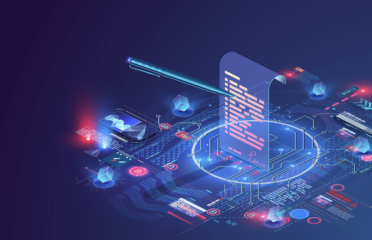Globacap at Digital Assets Week 2022

Globacap CEO and co-founder, Myles Milston, recently attended Digital Assets Week in London where he took part in two panels and led the discussion on the present and near future of digital assets. Digital Assets Week (DAW), with three large-scale events running annually in London, California, and Singapore, has become the core venue where institutional investors and fintech innovators meet to explore the opportunities digitisation brings to financial services.
The first panel featuring Myles, Private Markets: What is the Digital Ecosystem Going to Look Like?, saw him take the stage alongside Moran Levinovitz from HSBC Corporate Ventures, Andrew Murray from Strategic Investments at Citi, Valerio Matriciani from Eternyze AG, and Anthony Woolley from Ownera.
Registered versus bearer instruments
Myles began by emphasising the fundamental if often overlooked importance of the distinction between bearer and registered instruments. With bearer instruments having been all but extinct due to the obvious impracticalities and security risks of ownership being solely established by possession, for digital assets to gain wider traction it is essential for them to make the transition from being simple bearer instruments, as cryptocurrencies are, to fully registered securities.
Myles argued that following the dematerialisation processes which have revolutionised public markets over the last decades of the 20th century, public markets are in essence already largely digital, with digital book-entries having almost totally replaced paper-form securities today. Where digitalisation has yet to appear and make an impact is in the significantly more arcane world of private markets.
The fact that private markets still rely on manual processes of a heavily labour- and time-intensive nature means the scope for digitisation to bring efficiency gains is vast. Myles underlines how quick and substantive the progress made to digitising back-office processes has been; today, everything from private placements, legal settlement finality in terms of both primary and secondary transactions, register management, all the way down to stamp duty, stock transfer forms, and the issue and re-issue of share certificates has been digitised.
Compliance is key
The end result of all these processes coming together is the ability to create tokenised assets which can be transferred easily and traded continuously. The progress of the past few years means there is now the ability to tokenise not just bearer instruments, but actually registered securities. This is the key development which makes institutional investors and asset managers interested because now they can handle digital assets in a way that remains fully compliant and legally secure.
Myles summarised that the Globacap digital ecosystem is currently populated entirely by traditional assets – fund units, equity, debt, convertible notes, etc – but traditional assets which have been converted into and stored in a digital format. However, administrative pain-points remain where this digital, automated system touches tax and regulatory authorities still operating with manual processes.
Myles gives the example that Covid compelled HMRC to start accepting e-signatures instead of requesting physical, written signatures, but these e-signatures are still printed out and then stamped by hand as they move through HMRC whenever a transfer of private shares takes place. To this extent, there is an upper bound to how far digitisation can go without an accelerated pace of reform from the relevant government agencies.
Digitisation enhances liquidity
However, despite this, the reduction in friction points due to digitisation is nonetheless very substantial and is leading to a dramatic rise in liquidity in private assets as they become more transferable. Nasdaq Private Market (NPM) remains the largest such venue by far, but even here automation has not yet been applied to the final stages of trade settlement. The volume of transactions on NPM shows the scale of demand out there for private assets – the ability to digitise more and more of these traditional assets and the processes relating to their management and transfer will surely bring more and more accredited investors into the fast-growing private markets space in the coming years.
Concluding the session, Myles observed that any time transaction costs fall, transaction volume has a strong tendency to rise. Likewise, anytime secondary liquidity becomes more accessible, the risk premium of making the initial investment declines, thus allowing more capital to be allocated to such previously risky or illiquid investments in the future without exceeding the previous risk parameters.
Why has progress been slower than expected?
Myles’ second panel, The long road to securities becoming digital (The path to liquidity – harnessing data to drive digital solutions), featured Emma Joyce from GBBC Digital Finance, Michael Demissie from BNY Mellon, Jacek Wieclawski from Rabobank, Rahul Banerjee from BondbloX, and Stephen Prosperi from the Depository Trust and Clearing Corporation.
Tackling the question of what are the main advantages of markets going digital, Myles reminded the audience that it was only 10 years ago physical maps would still have been more common than Google maps, or other electronic navigation methods. This underlines quite how fast digital transformation can happen, and how few if anyone would want to go back to the old ways once this transition has occurred.
Linking to private capital markets, Myles argued that the expensive and time-consuming processes that dominate private transactions can be minimised if not totally reduced by going digital. This speeds-up and lowers costs for all participants. In this sense, digitisation means removing a mass of slow, laborious work and therefore increases the overall efficiency of the market.
This is bringing private markets closer to their already efficient public counterparts. Myles is keen to emphasise that many of the tools to improve efficiency in private markets are already available – the fact that private markets have grown at an average of 1.7 times the rate of public markets in the past few years simply serves as an added incentive to large institutions to enter this space. This reduced cost of transactions has the knock on effect of lowering the risk premium, therefore meaning more capital can be allocated to private markets by risk-constrained allocators, and this will further accelerate the development of private market liquidity and trading infrastructure.
What does blockchain add?
There was broad consensus on the panel that blockchain has a massive role to play in terms of how traditional trading infrastructure will be overhauled in the coming years. Speeding up settle and clearing times with the use of blockchain is a key part of improving private markets operationally and moving them closer to where public markets are.
In terms of when all assets will become digital, Myles suggests that this process will be lead by central market infrastructure providers. Myles talked about the public-private interoperability Globacap has built with the Johannesburg Stock Exchange and argued that it will be similar projects led by central market infrastructure providers that will unlock wider adoption of digital methods.
Myles concluded by reminding the audience of the importance of the learning curve traditional financial institutions must go on to catch up to, and take advantage of, the myriad of possibilities the digital transition can deliver.

















